Uppercase Shortcut in Excel
MS Excel is one of the most powerful spreadsheet software with a distinct range of features. Although it offers numerous advanced features, it lacks some essential features when we think of text modification. For instance, Excel has no direct option or shortcut key to use Change Case (such as uppercase, lowercase, etc.) feature like MS Word.

Even though Excel is not known as word processing software, we have to deal with the text data and sentences within the Excel cells. Sometimes, we may typically need the Change Case feature to adjust the text presentation accordingly. For instance, we may have to change some names from lowercase to uppercase. If we edit all the names one by one, it becomes a tedious task, especially when dealing with vast amounts of data.
This article discusses some alternate shortcuts to use uppercase in Excel to convert lowercase or mixed case data into all-caps. But before we discuss the shortcuts, let us take a quick overview of the uppercase option and its importance in text modification.
What is the uppercase feature, and what is its use?
The uppercase feature is defined as a typeface of larger characters while typing anything in the Word processing software. It is also known as Caps, AllCaps, and Capital.
For example, if we type a, b, and c, it represents the lowercase letters or characters. Besides, when we type A, B and C, it represents the uppercase letters. When we need to type in uppercase, we typically use the caps lock button to enter everything in all caps. Alternately, we can press the character keys while holding the Shift key to make text capital.
In MS Word, the case feature shortcut is given on ribbon that helps users to change between different cases easily, as shown below:
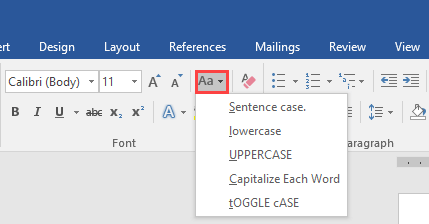
Unfortunately, Excel lacks this feature as built-in options or direct tool/ shortcut. However, the feature is way more needed in Excel than MS Word. Because if we type everything in all uppercase in Word, it looks like we are yelling and making it hard to read for the readers. Besides, in Excel, we need uppercase for some specific type of data, such as names, IDs, etc.
Excel Uppercase Shortcut
Since Excel lacks a quick shortcut button to use the uppercase, we need to use the UPPER formula to change the data to uppercase in Excel. The UPPER formula changes every letter inside specific cells to uppercase. Although it works perfectly, it is not as fast as using the shortcuts in Excel for other features. However, we have two significant alternate Uppercase Shortcuts in Excel, as listed below:
- Uppercase Shortcut in Quick Access Toolbar
- Uppercase Keyboard Key Shortcut
We can leverage any of the above uppercase shortcuts and change small and mixed caps to complete uppercase. Let us understand each shortcut in detail:
Note: It is highly recommended to back up the original file before changing or converting the text to lowercase. This is necessary for those scenarios when we mess with the data while trying the steps. Having a backup will help us recover our data easily.
Shortcut 1: Uppercase Shortcut in Quick Access Toolbar
To use the uppercase shortcut from the quick access toolbar, we have to add it first on the toolbar. However, we cannot add the shortcut for uppercase like adding any other general shortcut or feature, and it is because there is no built-in uppercase option in Excel. Therefore, we must first insert a VBA code to convert selected cells to uppercase and then create a shortcut to use this script from the shortcut.
Let us perform the necessary steps to configure the uppercase shortcut in the quick access toolbar:
- First, we need to launch the VBA editor to insert the script/ code. To open the VBA editor in Excel, we must simultaneously press the shortcut keys Left Alt + F11. We might also need to press the Fn key for some keyboards before pressing F11 to activate the function keys.
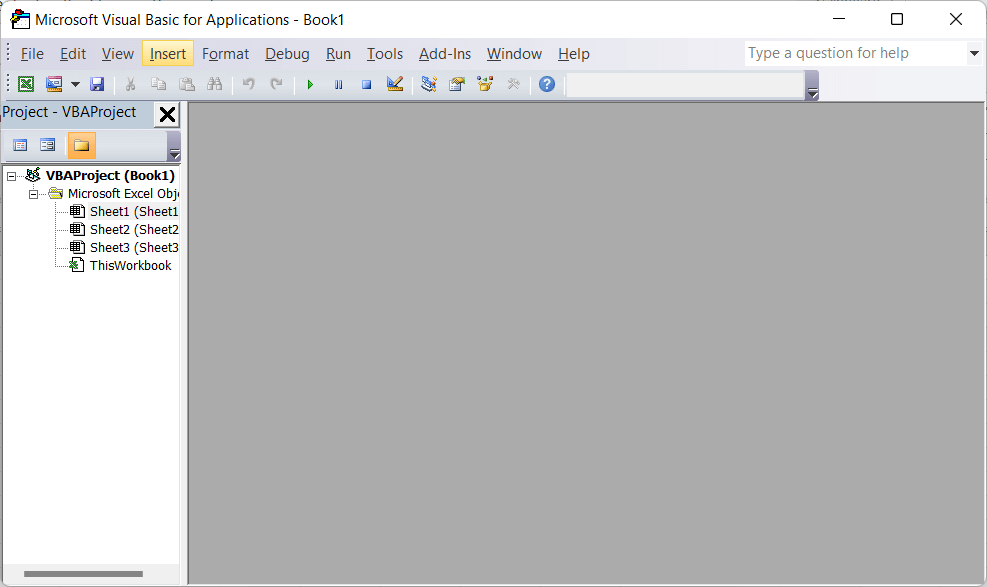
- Next, we need to go to the Insert > Module and copy-paste the following code into the VBA editor:
We need to save the VBA script and close the editor.
- After that, we need to click the Customize Quick Access Toolbar drop-down icon, as shown below:

- We need to select the More Commands option from the list:
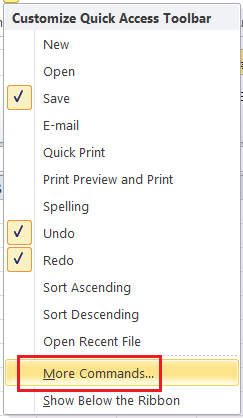
- We need to select Macros from the list under ‘Choose commands from‘ and click the AllCaps macro that we added with the VBA editor in the next window.
Also, we need to click the Add >> button, as shown below:
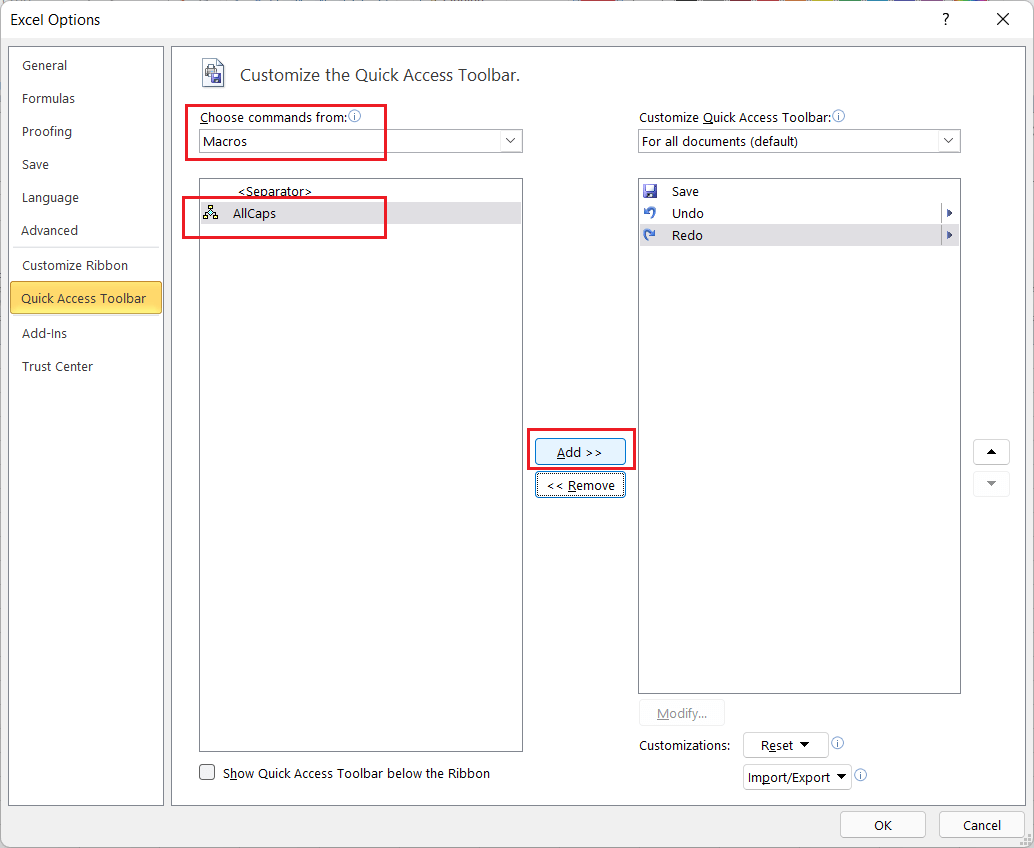
- After clicking the Add >> button, we will see that the AllCaps macro is added to the list on the right side box. We need to select the AllCaps macro from the list and click the Modify button to add a custom icon for the shortcut.
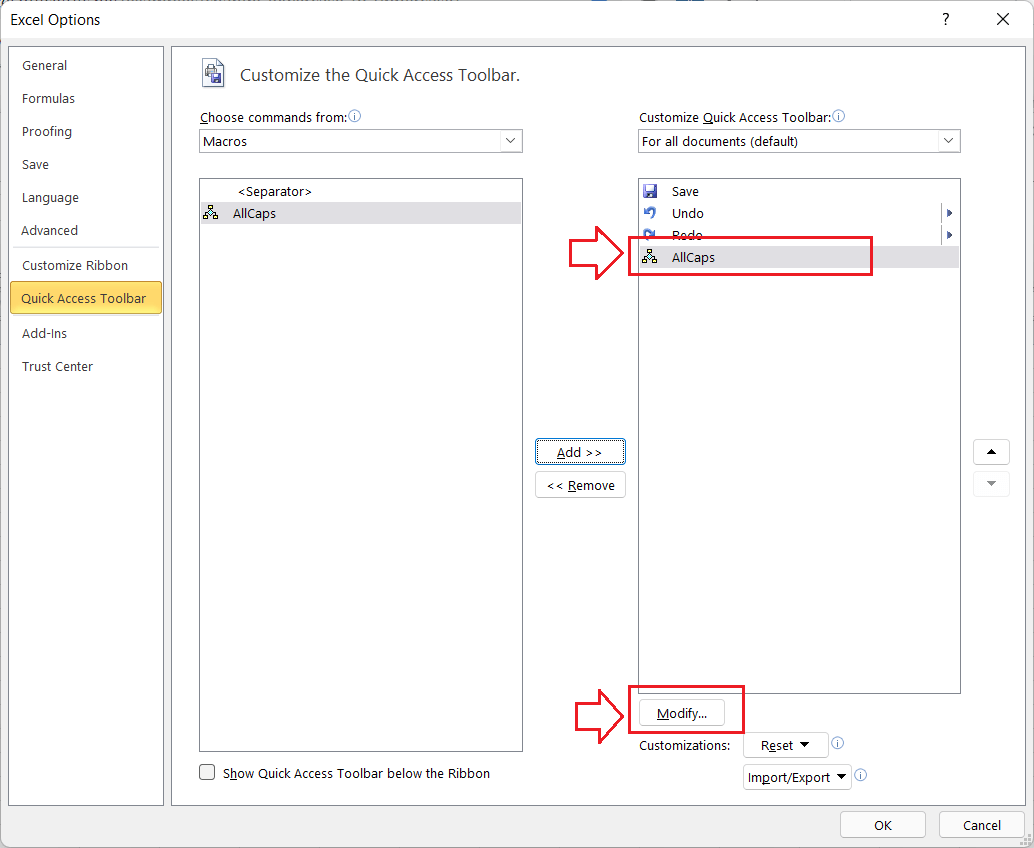
However, we can ignore this step if we don’t have any macro shortcuts on the quick access toolbar. - Lastly, we must select the desired icon and click the OK
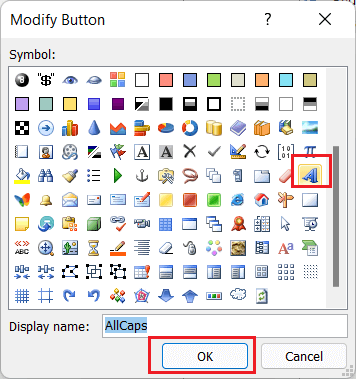
The shortcut for the uppercase will be instantly added to the quick access toolbar, as shown below:

Whenever we want to make the text all caps (uppercase), we must select the corresponding cells and click the AllCaps shortcut from the quick access toolbar.
We only need to add a shortcut in the quick access toolbar once. Later, we can use the shortcut many times on the entire active Excel window with just a click. This is useful when dealing with the vast amounts of data in a sheet.
Shortcut 2: Uppercase Keyboard Key Shortcut
Although using the Uppercase shortcut is quite easy, some users prefer using a keyboard over a mouse. We can also use the custom keyboard shortcut/ keys for the uppercase feature in Excel. Like shortcut 1, we also need to configure shortcut 2 manually. According to this process, we first create a macro using the VBA code and then assign custom shortcuts or keys for the macro.
Let us perform the necessary steps to configure the uppercase keyboard shortcut key shortcut:
- Like the previous method, we first need to open the VBA editor using the shortcut Left Alt + F11, go to Insert > Module and copy-paste the following code:
We can save the script to our file and then close the VBA editor.
- Next, we need to click the View tab and select the Macros >> View Macros option, as shown below:
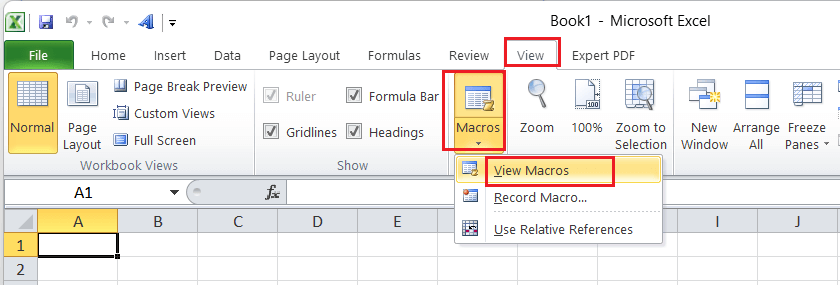
- In the next (Macro window) window, we need to select the AllCaps macro and click the Options button to access related features.
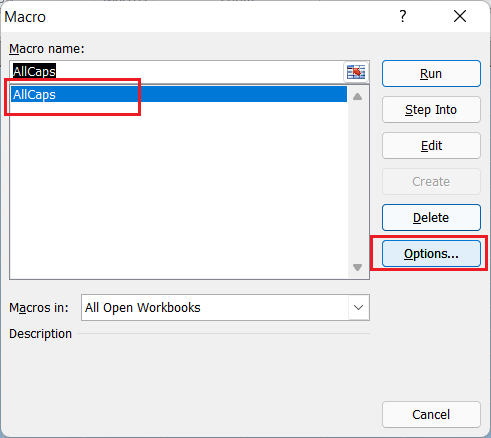
- In the Macro Options window, we must assign the desired shortcut key for the corresponding macro, i.e. AllCaps.
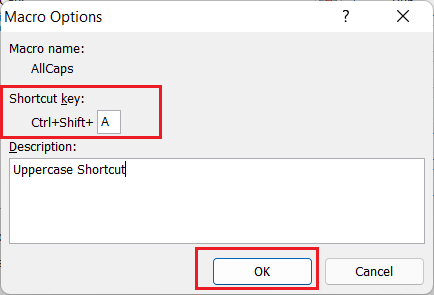
Whenever we want to make the text all caps (uppercase), we must select the corresponding cells and press the shortcut Ctrl + Shift + A using the keyboard. The selected cells or text will be converted to uppercase instantly at one go.
It is important to note that we have to create a unique shortcut key for the corresponding macro. Suppose we create any shortcut that is already present in Excel (default or custom). In that case, the new shortcut will override the previous shortcut, and we may lose any specific shortcut for another feature.
Excel Uppercase Shortcut Example
After adding the uppercase shortcut in Excel, we can make our text all caps in the desired workbook using the shortcut. Since we have added two uppercase shortcuts, we can leverage any of the desired shortcuts to change the cells’ data accordingly.
For example, consider the following excel sheet with some employees’ data, such as the employees’ names, IDs, mobile numbers, etc.
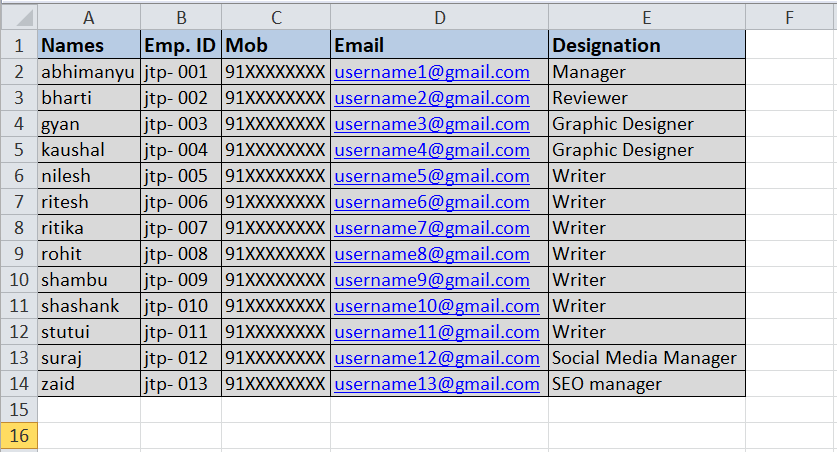
In the above Excel sheet, we have employees’ names and their IDs in lowercase and suppose we want to change all of them to uppercase at once with a shortcut. Therefore, we need to perform the following steps:
- First, we need to select all the cells with employees’ name and their IDs. For this, we can click on the column headers of respective columns. It means that we click on the column header of column A and column B while holding down the Ctrl key. Doing this will select both the columns and their respective cells.
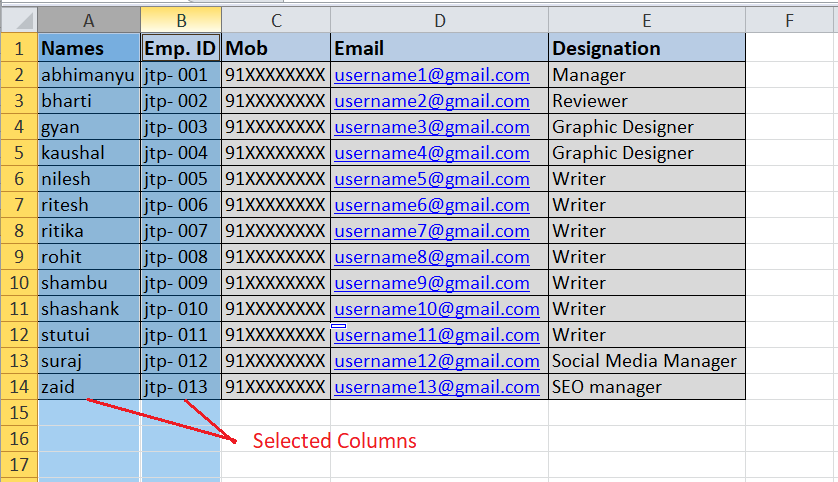
- Once the desired cells have been selected, we need to use any of the uppercase shortcuts that we added. Because of ease of usability, we use the keyboard shortcut Ctrl + Shift + A. As soon as we press the shortcut key, the associated macro runs and converts all the selected cells to uppercase. Our example sheet looks like this after using the uppercase shortcut:
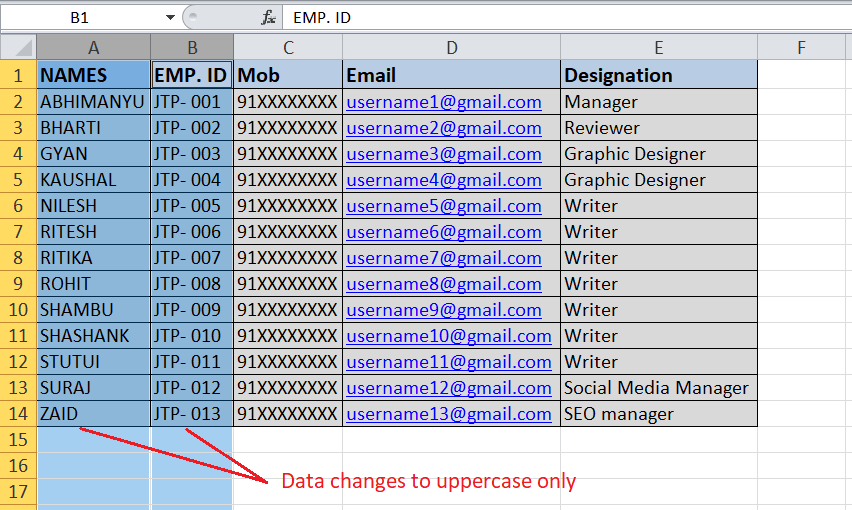
That is how we can use the uppercase shortcut in Excel and change/ convert all the desired text to all caps or uppercase.
Important Points to Remember
- There is no definite keyboard shortcut key for changing text to uppercase in Excel. However, a customized macro can be created to get a keyboard shortcut key and/or a shortcut icon on the quick access toolbar to use the uppercase feature.
- When we use the macro to create a shortcut for the uppercase in Excel, the existing file will be converted to XLSM extension if we save the applied changes. Therefore, we must work accordingly.
- While creating a custom keyboard shortcut for uppercase, we must ensure that the new shortcut does not exist already in Excel. If there is already the same shortcut, it will be overridden by a new one.
- It is always recommended to take a backup of the original file before making changes to it. So, if anything goes wrong, we don’t lose our data.




